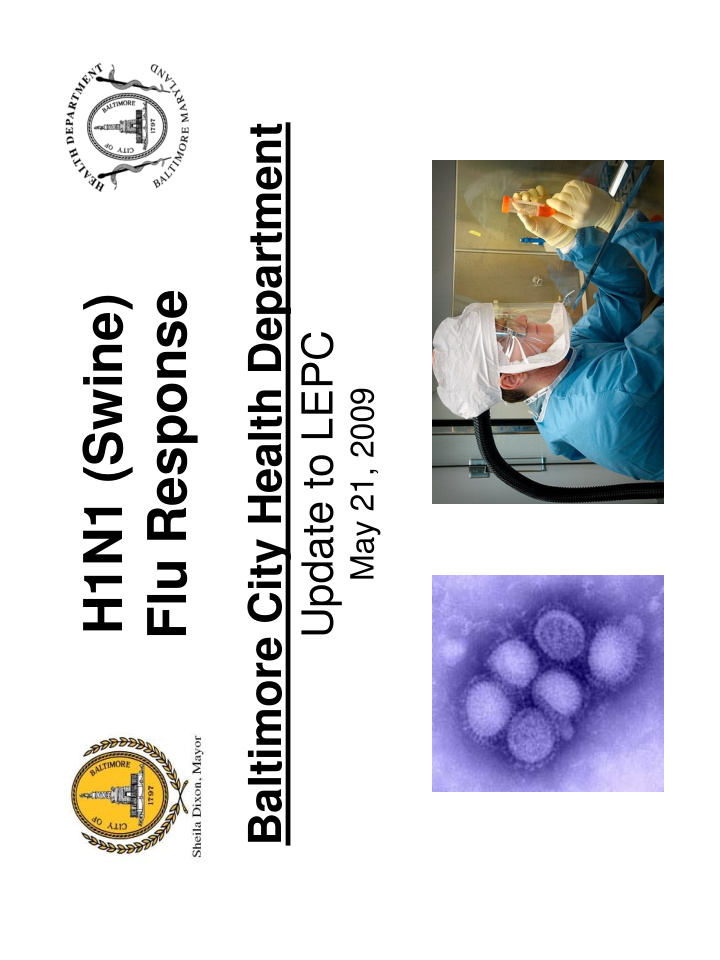



Baltimore City Health Department H1N1 (Swine) Flu Response Update to LEPC May 21, 2009
U.S. Human Cases of H1N1 Flu Infection (Information as of May 20, 11:00am) • 5,710 Confirmed Cases in US – 8 Deaths in US – 48 States in US • Maryland has 39 Confirmed Cases
About H1N1 (Swine) Flu H1N1 (referred to as “swine flu” early on) is a new influenza virus causing illness in people. This new virus was first detected in people in April 2009 in the United States. This virus is spreading from person-to-person, probably in much the same way that regular seasonal influenza viruses spread.
Baltimore Response Action Steps o 311 script for calls regarding swine flu o Created a website o Participated in daily conference calls with DHMH, other MD local health departments, and MD hospitals o Met with 1 st responders to discuss infection control measures o Conducted biosurveillance o Worked with City Schools o Issued a press release and held press conference o Convened a panel of experts to discuss response efforts moving forward and public messaging. o Compiled flu prevention and healthy habits outreach materials
Incident Management Activities • Conduct weekday meetings of team. • Conduct weekend conference calls. • Triage of calls and issues. • Share situational awareness info. • Provide weekday updates to City agencies and City hospitals. • Communicate with healthcare providers and the public.
BALTIMORE CITY HEALTH DEPARTMENT H1N1 Transitional Period Incident Command System (ICS) April 2009 Commissioner Olivia Farrow Operations Incident OPHPR Public Info Anne Bailowitz, Steve Hankins Debbie Knorr, Commander (IC) Officer (PIO) Jess George Meghan Butasek, Rianna Brown, ACD Brian Jennifer Martin Mary Grace Munoz, Kompan Ngamsnga School Health Melissa Houston, Francine Childs Admin/Logistics Planning Michelle Spencer Environmental Health Carrie Durham, Bernie Bochenek Facilities Legal Dourakine Rosarion Nicki Humphries, Michael Schrock Clinical Information Technology Expert Taskforce Curtis Davis Olivia Farrow Internal (BCHD) Charlene Brown, Sherry Ketemepi Fiscal Management Mental Health Thomas Kim Jackie Duval-Harvey External Anne Bailowitz, Human Resources Steve Hankins Tanisha Bomani External (School Health only) Melissa Houston
What You Can Do to Prepare • City-wide Preparedness – Develop/Update Continuity of Operations (COOP) info for your agency/organization. – Promote good health habits. – Stay informed of news, website and email updates. • Personal Preparedness – Make a plan for yourself and your family. – Practice good health habits.
Continuity of Operations (COOP) • All Hazards COOP Planning – Purpose : Continue essential functions during any type of disruption to services. • Pandemic Flu COOP Plans: – Purpose : Place COOP within the context of a contagious disease outbreak disruption to business activities. – What can I do if my business doesn’t have a Pan Flu COOP? – How do we use it?
Department of Health and Human Services Business Influenza Planning Checklist http://www.pandemicflu.gov/
Plan for the impact of a pandemic on your business: • Identify an emergency planning coordinator and/or team. • Identify essential employees and other critical inputs. • Find up-to-date, reliable pandemic information from community public health, emergency management, and other sources. • Establish an emergency communications plan. • Implement an exercise/drill to test your plan.
Plan for the impact of a pandemic on your employees and customers: • Forecast and allow for employee absences during a pandemic. • Implement guidelines to modify the frequency and type of face-to-face contact. • Encourage annual influenza vaccination for employees. • Identify employees and key customers with special needs, and incorporate the requirements of such persons into your preparedness plan.
Establish policies to be implemented during a pandemic: • Establish policies for employee compensation and sick-leave absences. • Establish policies for flexible worksite and work hours. • Establish policies for preventing influenza spread at the worksite. • Set up authorities, triggers, and procedures for activating and terminating the response plan.
Allocate resources to protect your employees and customers during a pandemic: • Provide infection control supplies. • Enhance communications and information technology infrastructures. • Ensure availability of medical consultation and advice for emergency response.
Communicate to and educate your employees: • Develop and disseminate information covering pandemic fundamentals, personal and family protection and response strategies. • Disseminate information to employees about your business emergency plan. • Develop ways for communicating pandemic status and actions. • Identify community sources for timely and accurate pandemic information
Coordinate with external organizations and help your community: • Collaborate with federal, state, and local public health agencies and emergency responders. • Communicate with local and state public health agencies and emergency responders about the assets and/or services your business could contribute to the community. • Share best practices with other businesses in to improve community response efforts.
What can I do to protect myself from getting sick?
Cover Your Cough Cover your nose and mouth with a tissue when you cough or sneeze. Throw the tissue in the trash after you use it.
Hand Hygiene Wash your hands often with soap and water, especially after you cough or sneeze.
Other Important Actions • Follow public health advice regarding social distancing measures. • Be prepared in case you or a family member gets sick and needs to stay home.
Information Resources • Baltimore City Health Department’s Website www.baltimorehealth.org – Featuring Links to: • Maryland Dept. of Health and Mental Hygiene • Centers for Disease Control • World Health Organization • Call 311
Recommend
More recommend